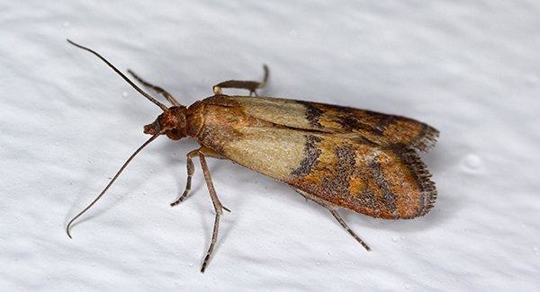It is unsettling that a great number of pests are capable of contaminating food and surfaces. Ants and roaches are just two examples. These bugs bear bacteria on their bodies that trigger illnesses such as dysentery and salmonella. There’s another critter Milford home and business owners should be wary of, and that’s an Indian meal moth.
Indian meal moths are also known as pantry moths. As their name notes, being in your pantry (or your kitchen) is their primary objective. Understanding their mode of operation can give you perspective for preventive measures. And if you need assistance, learn how Big Blue Bug Solutions will come through in a lurch.
How Do Indian Meal Moths Look & Behave?
Indian meal moths are about ⅜ of an inch long, with a wingspan of ⅝ of an inch. While their wings are predominantly gray, there’s a bronze or brown tint towards the bottom. The multicolored shading is what differentiates these moths from other kinds. Their larvae are pink, cream, or yellow-green, and have brown heads. It’s important to remember how they look because they do the most damage.
Adult Indian meal moths creep into stored food while it’s being packaged and distributed at factories.Once inside, they begin to lay eggs. Any surrounding humidity facilitates this process. The larvae will instantly begin feeding when they emerge from their eggs. These moths tend to target the following items:
- Spices
- Grains
- Rice
- Dry goods
- Flour
- Fruit
- Pet food
Unlike many pests, Indian meal moths don’t taint food because they harbor parasites and diseases. They do it with their fecal waste and webbing. These substances change the taste of whatever they infest, and they promote mold growth. Anything they’ve come in contact with should be discarded immediately. If you see Indian meal moths or their larvae, you certainly have an infestation. These creatures will fly to other parts of your property, so don’t confuse them for fabric bugs. Dim light attracts them.
How Can Indian Meal Moths Be Prevented?
One could argue that it’s impossible to keep Indian meal moths out, but that isn’t true. You can’t control what occurs in a food packaging plant or distribution center. However, you can dictate what happens inside your property. The key to reducing the chances of a meal moth invasion is being hands-on with your food storage and building preservation:
- Regularly inspect food packages; this goes for pet meals too.
- Remove all items from your pantries and cabinets to perform deep cleaning. Do this often.
- Check your ceilings, walls, foundations, and appliances for cracks and voids. If you find any, have them sealed.
- Put food in glass or plastic canisters that are airtight, whether it’s for pets or humans.
What Can Big Blue Bug Solutions Do About Indian Meal Moths?
At Big Blue Bug Solutions, we don’t believe “one size fits all.” Our inexpensive control plans include specialized treatments. They are designed to exterminate the exact pest that’s bothering you. This is to guarantee effectiveness. If our insured and licensed technicians are called about Indian meal moths, that’s what they’ll address. Safe and environmentally friendly products and state-of-the-art equipment will be used to wipe those critters out. You won’t have to think twice about eating from your pantry again. Reach out to us today!

